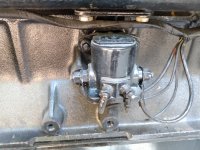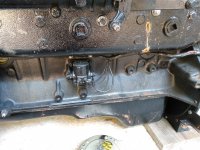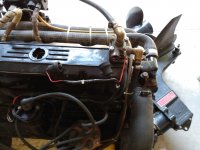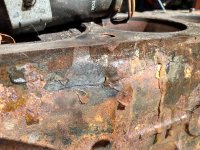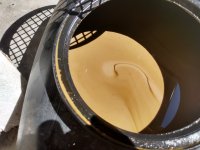Got a "free boat" with 1974 Mercruiser 165. The outdrive appears to be in very good shape (said to have been rebuilt about 5 years ago). The boat has been sitting for the last 4 years - not winterized, and it got in the 20s for several days at a time, several times. The engine had about 4-1/2 qts of "oilish type substance" (ha, ha). It was so thick it was hard to drain - gray emulsified
mess with lots of water. I can't imagine that the block is not cracked. Solenoid pulls in, but the starter is completely frozen. Removed exhaust manifold and cylinder head and they both look pretty good. Carburetor looks crummy.
Just after I got the boat and determined the engine condition, I was able to get a very nice looking Mercruiser 160 and outdrive. The exhaust manifold on this one looks good, but it has the "reverse flow" setup, minus the elbow/adapter going into the side of the exhaust elbow. The carburetor looks pristine. It looks like the owner was going to do some maintenance or possibly replace the exhaust elbow, but never finished. The 160 was in a Reinell (looked immaculate) that was sitting in a heated garage for the last several years. The owner developed Alzheimer's/dementia, so the boat just sat. Anyway, I got the motor and outdrive for $200 and figured it was worth it to take a chance that I could get one engine running!
The oil in the 160 looks like it just came out of the jug. There is literally no grease or grime on the engine. It turns over easily. Now my questions.
It seems that it might be easy to get the 160 running without too much effort or expense, so that's my Plan A.
1) I could use the 160 engine with it's existing manifold (reverse flow, but I would need to find an adapter to thread into the exhaust elbow), OR I could use the manifold from the 165. Any pros or cons that some of you might know about? I guess under certain conditions, some of the 160/165 manifolds would develop "hot spots", hence the "reverse flow" kit. From what I have been able to find online, it doesn't seem that the "reverse flow" was used much.
2) The 165 carburetor looks crummy, the 160 carburetor looks very good. Both are Rochester 2GC, but the configurations are slightly different. The 165 has a fuel inlet, and a valve cover breather hose connection that goes into the flame arrestor. The 160 has the same fuel inlet, but no breather hose to the flame arrestor. The valve cover on the 160 has a breather cap.
Also, the 160 carb has a tee on the starboard side with one line going to the valve cover, and then another going to the bottom of the Carter fuel pump. I am planning to use the 160 carb, but wondering what the purpose is of the 2 lines on the tee?
3) I think I can figure out the electrical connections, but there are a couple of differences on the 160. There is a FloScan fuel sensor inline from the fuel pump to the carburetor. I guess these are used to calculate fuel consumption/efficiency. I'm assuming I can just delete this all together. The other difference is some kind of solenoid on the port side of the block. It has 4 wire connections, but I don't see anything else. Anyone know what this might be?
I've finished removing the 165 from the boat, and cleaned up the hull/floor. Debating whether or not to remove the transom plate an replace the u-joint/exhaust bellows or leave as is. The owner that gave me the boat said there was a small amount of water accumulating and that he had to run the small bilge pump now and again. Don't see any other "leak candidates", so thought it might be one of the bellows (or maybe he just had a bad boat plug).
My next step will be to decide on the final configuration and then try and run the 160 engine out of the boat. Any help with the questions above, or other advice will be greatly appreciated!
Gregg G.
mess with lots of water. I can't imagine that the block is not cracked. Solenoid pulls in, but the starter is completely frozen. Removed exhaust manifold and cylinder head and they both look pretty good. Carburetor looks crummy.
Just after I got the boat and determined the engine condition, I was able to get a very nice looking Mercruiser 160 and outdrive. The exhaust manifold on this one looks good, but it has the "reverse flow" setup, minus the elbow/adapter going into the side of the exhaust elbow. The carburetor looks pristine. It looks like the owner was going to do some maintenance or possibly replace the exhaust elbow, but never finished. The 160 was in a Reinell (looked immaculate) that was sitting in a heated garage for the last several years. The owner developed Alzheimer's/dementia, so the boat just sat. Anyway, I got the motor and outdrive for $200 and figured it was worth it to take a chance that I could get one engine running!
The oil in the 160 looks like it just came out of the jug. There is literally no grease or grime on the engine. It turns over easily. Now my questions.
It seems that it might be easy to get the 160 running without too much effort or expense, so that's my Plan A.
1) I could use the 160 engine with it's existing manifold (reverse flow, but I would need to find an adapter to thread into the exhaust elbow), OR I could use the manifold from the 165. Any pros or cons that some of you might know about? I guess under certain conditions, some of the 160/165 manifolds would develop "hot spots", hence the "reverse flow" kit. From what I have been able to find online, it doesn't seem that the "reverse flow" was used much.
2) The 165 carburetor looks crummy, the 160 carburetor looks very good. Both are Rochester 2GC, but the configurations are slightly different. The 165 has a fuel inlet, and a valve cover breather hose connection that goes into the flame arrestor. The 160 has the same fuel inlet, but no breather hose to the flame arrestor. The valve cover on the 160 has a breather cap.
Also, the 160 carb has a tee on the starboard side with one line going to the valve cover, and then another going to the bottom of the Carter fuel pump. I am planning to use the 160 carb, but wondering what the purpose is of the 2 lines on the tee?
3) I think I can figure out the electrical connections, but there are a couple of differences on the 160. There is a FloScan fuel sensor inline from the fuel pump to the carburetor. I guess these are used to calculate fuel consumption/efficiency. I'm assuming I can just delete this all together. The other difference is some kind of solenoid on the port side of the block. It has 4 wire connections, but I don't see anything else. Anyone know what this might be?
I've finished removing the 165 from the boat, and cleaned up the hull/floor. Debating whether or not to remove the transom plate an replace the u-joint/exhaust bellows or leave as is. The owner that gave me the boat said there was a small amount of water accumulating and that he had to run the small bilge pump now and again. Don't see any other "leak candidates", so thought it might be one of the bellows (or maybe he just had a bad boat plug).
My next step will be to decide on the final configuration and then try and run the 160 engine out of the boat. Any help with the questions above, or other advice will be greatly appreciated!
Gregg G.





















